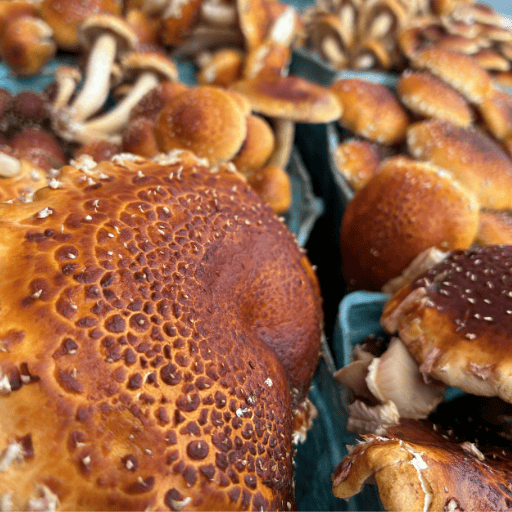Locally grown chestnut mushrooms straight from our location in Amherst.
Rich, earthy flavor with a satisfying bite

Chestnut mushrooms are a favorite among chefs for their deep umami flavor and firm texture. Grown in dense clusters with glossy caramel-colored caps, they’re as beautiful as they are delicious. When cooked, they develop a rich, nutty flavor with just a hint of sweetness and a meaty texture that holds up well in a wide range of dishes.
Unlike many mushrooms, Chestnuts have tender stems that can be cooked right along with the caps — no trimming needed. Whether tossed in olive oil and roasted, stir-fried with seasonal vegetables, or layered into a hearty soup, these mushrooms bring depth and heartiness to the table.
Cooking with Chestnut mushrooms
Chestnut mushrooms work especially well in hot dishes where you want the mushrooms to hold their shape and soak up flavor. Their savory character pairs beautifully with garlic, soy sauce, rosemary, butter, or even a splash of wine. They’re excellent in stir-fries, ramen, pasta, or as a topping on flatbreads. You can also grill or roast them for a concentrated, earthy taste that plays well with just about any protein or vegetable.
Want to experiment? Try caramelizing them slowly in a cast-iron pan or blending them into a mushroom pâté for a savory spread.
Nutritional value and potential benefits
Chestnut mushrooms are a nutritious choice for any diet. They’re low in calories, fat-free, and packed with essential nutrients like B vitamins, selenium, copper, and antioxidants. They also contain beta-glucans, a type of fiber that may support immune function and gut health. Because they have a higher density and texture than common white mushrooms, they can be especially satisfying in vegetarian and vegan cooking.
Storage and preparation
To store, keep them in a paper bag in the refrigerator and use within 5 to 7 days. Cleaning is easy — just brush off any dirt with a soft brush or cloth. If the base of the cluster is tough or dirty, you can trim it, but most of the time, the entire mushroom can be used. No peeling required.
Fun facts about Chestnuts
Chestnut mushrooms may resemble cremini or baby bellas, but they’re a different species altogether. Their caps often have a slightly glossy or scaly appearance, depending on how they’re grown. In the wild, similar mushrooms grow on decaying hardwood trees, but cultivated Chestnuts are more consistent and safe. Their firm texture and rich taste have made them a staple in European and Asian cuisine for centuries — and now they’re a standout in local kitchens here in Amherst.
